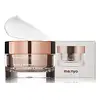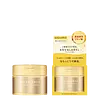What's inside
What's inside
 Key Ingredients
Key Ingredients

 Benefits
Benefits

 Concerns
Concerns

 Ingredients Side-by-side
Ingredients Side-by-side

Bifida Ferment Lysate 62%
Skin ConditioningButylene Glycol
HumectantCaprylic/Capric Triglyceride
MaskingCetyl Ethylhexanoate
EmollientGlycerin
HumectantSqualane
EmollientNiacinamide
Smoothing1,2-Hexanediol
Skin ConditioningCetearyl Alcohol
EmollientPolyglyceryl-2 Stearate
EmulsifyingCutibacterium Granulosum Ferment Extract Filtrate
EmollientCoco-Caprylate/Caprate
EmollientLactobacillus/Pumpkin Fruit Ferment Filtrate
Skin ConditioningAureobasidium Pullulans Ferment
Skin ConditioningBetaine
HumectantPanthenol
Skin ConditioningAcetyl Hexapeptide-8
HumectantPalmitoyl Tripeptide-1
Skin ConditioningCopper Tripeptide-1
Skin ConditioningSh-Polypeptide-1
Skin ConditioningSh-Oligopeptide-1
Skin ConditioningGlyceryl Stearate
EmollientStearyl Alcohol
EmollientPolyglyceryl-3 Methylglucose Distearate
EmulsifyingCeramide NP
Skin ConditioningCeramide AP
Skin ConditioningCeramide As
Skin ConditioningCeramide Ns
Skin ConditioningCeramide EOP
Skin ConditioningEpigallocatechin Gallate
AntioxidantGlyceryl Stearate Se
EmulsifyingSorbitan Stearate
EmulsifyingDipropylene Glycol
HumectantIsopropyl Myristate
EmollientSodium Carbomer
Emulsion StabilisingHydroxyethyl Acrylate/Sodium Acryloyldimethyl Taurate Copolymer
Emulsion StabilisingGlyceryl Caprylate
EmollientSodium Hyaluronate
HumectantHydroxypropyltrimonium Hyaluronate
Hydrolyzed Hyaluronic Acid
HumectantPotassium Hyaluronate
Skin ConditioningHydrolyzed Sodium Hyaluronate
Skin ConditioningSodium Hyaluronate Crosspolymer
HumectantHyaluronic Acid
HumectantSodium Acetylated Hyaluronate
HumectantWater
Skin ConditioningEthylhexylglycerin
Skin ConditioningScutellaria Baicalensis Root Extract
AstringentPanax Ginseng Callus Culture Extract
Skin ConditioningPanax Ginseng Root Extract
EmollientHydrogenated Lecithin
EmulsifyingPhytosphingosine
Skin ConditioningCholesterol
EmollientHydrolyzed Algin
Stearic Acid
CleansingPhysalis Alkekengi Fruit Extract
Skin ConditioningFoeniculum Vulgare Fruit Extract
EmollientPhosphatidylcholine
EmulsifyingIllicium Verum Fruit Extract
PerfumingCaramel
Cosmetic ColorantDextrin
AbsorbentRosa Damascena Flower Oil
MaskingCaffeine
Skin ConditioningAdenosine
Skin ConditioningBifida Ferment Lysate 62%, Butylene Glycol, Caprylic/Capric Triglyceride, Cetyl Ethylhexanoate, Glycerin, Squalane, Niacinamide, 1,2-Hexanediol, Cetearyl Alcohol, Polyglyceryl-2 Stearate, Cutibacterium Granulosum Ferment Extract Filtrate, Coco-Caprylate/Caprate, Lactobacillus/Pumpkin Fruit Ferment Filtrate, Aureobasidium Pullulans Ferment, Betaine, Panthenol, Acetyl Hexapeptide-8, Palmitoyl Tripeptide-1, Copper Tripeptide-1, Sh-Polypeptide-1, Sh-Oligopeptide-1, Glyceryl Stearate, Stearyl Alcohol, Polyglyceryl-3 Methylglucose Distearate, Ceramide NP, Ceramide AP, Ceramide As, Ceramide Ns, Ceramide EOP, Epigallocatechin Gallate, Glyceryl Stearate Se, Sorbitan Stearate, Dipropylene Glycol, Isopropyl Myristate, Sodium Carbomer, Hydroxyethyl Acrylate/Sodium Acryloyldimethyl Taurate Copolymer, Glyceryl Caprylate, Sodium Hyaluronate, Hydroxypropyltrimonium Hyaluronate, Hydrolyzed Hyaluronic Acid, Potassium Hyaluronate, Hydrolyzed Sodium Hyaluronate, Sodium Hyaluronate Crosspolymer, Hyaluronic Acid, Sodium Acetylated Hyaluronate, Water, Ethylhexylglycerin, Scutellaria Baicalensis Root Extract, Panax Ginseng Callus Culture Extract, Panax Ginseng Root Extract, Hydrogenated Lecithin, Phytosphingosine, Cholesterol, Hydrolyzed Algin, Stearic Acid, Physalis Alkekengi Fruit Extract, Foeniculum Vulgare Fruit Extract, Phosphatidylcholine, Illicium Verum Fruit Extract, Caramel, Dextrin, Rosa Damascena Flower Oil, Caffeine, Adenosine
Water
Skin ConditioningGlycerin
HumectantDipropylene Glycol
HumectantAlcohol Denat.
AntimicrobialXylitol
HumectantDiglycerin
HumectantPEG-20
HumectantPentaerythrityl Tetraethylhexanoate
EmollientDimethicone
EmollientSodium Acrylate/Sodium Acryloyldimethyl Taurate Copolymer
Emulsion StabilisingEuphorbia Cerifera Cera
AstringentGlutamic Acid
HumectantSaccharomyces Ferment Lysate Filtrate
Skin ConditioningAspartic Acid
MaskingSqualane
EmollientLysine Hcl
Skin ConditioningPhytosteryl Macadamiate
Skin ConditioningSesamum Indicum Seed Oil
EmollientSimmondsia Chinensis Seed Oil
EmollientRetinyl Palmitate
Skin ConditioningPEG/PPG-14/7 Dimethyl Ether
Skin ConditioningSodium Acetylated Hyaluronate
HumectantSodium Hyaluronate
HumectantBetaine
HumectantMethionine
Skin ConditioningGlycine Max Seed Extract
Skin ConditioningSoluble Collagen
HumectantIsohexadecane
EmollientPEG-400
Emulsion StabilisingPolysorbate 80
EmulsifyingSorbitan Oleate
EmulsifyingTalc
AbrasiveDisodium EDTA
Acrylates/C10-30 Alkyl Acrylate Crosspolymer
Emulsion StabilisingDextrin Palmitate
EmulsifyingCalcium Stearate
Cosmetic ColorantAlanine
MaskingPotassium Hydroxide
BufferingPEG-9 Polydimethylsiloxyethyl Dimethicone
EmulsifyingTetramethylcyclotetrasiloxane
Zea Mays Oil
EmulsifyingCitric Acid
BufferingSodium Phosphate
BufferingTetradecene
EmollientBHT
AntioxidantButylene Glycol
HumectantTocopherol
AntioxidantPhenoxyethanol
PreservativeParfum
MaskingCI 77492
Cosmetic ColorantWater, Glycerin, Dipropylene Glycol, Alcohol Denat., Xylitol, Diglycerin, PEG-20, Pentaerythrityl Tetraethylhexanoate, Dimethicone, Sodium Acrylate/Sodium Acryloyldimethyl Taurate Copolymer, Euphorbia Cerifera Cera, Glutamic Acid, Saccharomyces Ferment Lysate Filtrate, Aspartic Acid, Squalane, Lysine Hcl, Phytosteryl Macadamiate, Sesamum Indicum Seed Oil, Simmondsia Chinensis Seed Oil, Retinyl Palmitate, PEG/PPG-14/7 Dimethyl Ether, Sodium Acetylated Hyaluronate, Sodium Hyaluronate, Betaine, Methionine, Glycine Max Seed Extract, Soluble Collagen, Isohexadecane, PEG-400, Polysorbate 80, Sorbitan Oleate, Talc, Disodium EDTA, Acrylates/C10-30 Alkyl Acrylate Crosspolymer, Dextrin Palmitate, Calcium Stearate, Alanine, Potassium Hydroxide, PEG-9 Polydimethylsiloxyethyl Dimethicone, Tetramethylcyclotetrasiloxane, Zea Mays Oil, Citric Acid, Sodium Phosphate, Tetradecene, BHT, Butylene Glycol, Tocopherol, Phenoxyethanol, Parfum, CI 77492
 Reviews
Reviews

Ingredients Explained
These ingredients are found in both products.
Ingredients higher up in an ingredient list are typically present in a larger amount.
Betaine is a common humectant (a substance that promotes retention of moisture). It's known to be gentle on the skin and can help balance hydration.
This ingredient is best for improving hydration and soothing irritated skin. Studies also show it helps even out skin tone.
Fun fact: Betaine is naturally created in the skin and body. The kind found within cosmetic products can be either plant-derived or synthetic.
Another name for betaine is trimethylglycine.
Learn more about BetaineButylene Glycol (or BG) is used within cosmetic products for a few different reasons:
Overall, Butylene Glycol is a safe and well-rounded ingredient that works well with other ingredients.
Though this ingredient works well with most skin types, some people with sensitive skin may experience a reaction such as allergic rashes, closed comedones, or itchiness.
Learn more about Butylene GlycolDipropylene Glycol is a synthetically created humectant, stabilizer, and solvent.
This ingredient helps:
Dipropylene glycol is technically an alcohol, but it belongs to the glycol family (often considered part of the ‘good’ alcohols). This means it is hydrating and gentle on skin unlike drying solvent alcohols like denatured alcohol.
As a masking agent, Dipropylene Glycol can be used to cover the smell of other ingredients. However, it does not have a scent.
Studies show Dipropylene Glycol is considered safe to use in skincare.
Learn more about Dipropylene GlycolGlycerin is already naturally found in your skin. It helps moisturize and protect your skin.
A study from 2016 found glycerin to be more effective as a humectant than AHAs and hyaluronic acid.
As a humectant, it helps the skin stay hydrated by pulling moisture to your skin. The low molecular weight of glycerin allows it to pull moisture into the deeper layers of your skin.
Hydrated skin improves your skin barrier; Your skin barrier helps protect against irritants and bacteria.
Glycerin has also been found to have antimicrobial and antiviral properties. Due to these properties, glycerin is often used in wound and burn treatments.
In cosmetics, glycerin is usually derived from plants such as soybean or palm. However, it can also be sourced from animals, such as tallow or animal fat.
This ingredient is organic, colorless, odorless, and non-toxic.
Glycerin is the name for this ingredient in American English. British English uses Glycerol/Glycerine.
Learn more about GlycerinSodium Acetylated Hyaluronate is a type of Hyaluronic Acid.
Hyaluronic Acids help moisturize, soothe, and protect the skin.
Read about common types of Hyaluronic Acid here:
Sodium Hyaluronate
Hydrolyzed Hyaluronic Acid
Hyaluronic Acid
Sodium Hyaluronate is hyaluronic acid's salt form. It is commonly derived from the sodium salt of hyaluronic acid.
Like hyaluronic acid, it is great at holding water and acts as a humectant. This makes it a great skin hydrating ingredient.
Sodium Hyaluronate is naturally occurring in our bodies and is mostly found in eye fluid and joints.
These are some other common types of Hyaluronic Acid:
Learn more about Sodium HyaluronateSqualane is an emollient that helps the skin hold onto moisture. It's an oily liquid that occurs naturally in certain types of fish and plant oils.
Because squalane boosts hydration in the skin, it also comes with plenty of benefits: it is an antioxidant and can help fight free radicals and skin damage. Squalane is also found to have a detoxifying effect when applied.
Squalane comes from squalene, which occurs naturally within the sebum of our skin. It is one of the oils our skin produces to keep itself hydrated. Squalane is the hydrogenated version of squalene and has a longer shelf life.
Research shows that squalane is non-irritating (even at 100% concentration).
In general, it's a fantastic ingredient. It does a great job at hydrating the skin, and it's suitable for those with sensitive skin.
The source of squalane may impact malassezia / fungal acne. This is because olive oil derived squalane can contain impurities such as fatty acids and plant waxes. Sugarcane derived squalane is recommended for anyone with malassezia concerns.
Is squalane vegan?
This depends on the source. Squalane can be derived from both plants and animals. Most squalane used in skincare comes from plants.
Please note: the source of squalane is only known if disclosed by the brand. We recommend reaching out to the brand if you have any questions about their squalane.
Read more about squalene with an "e".
Is squalane an oil?
Squalane is often called an oil, but it’s technically not; it’s a hydrocarbon, meaning it’s only made of carbon and hydrogen, unlike true oils which are triglycerides made of fatty acids and glycerol.
The term “oil-free” isn’t regulated, so companies can define it however they want. Some exclude all oils, while others just avoid mineral oil or comedogenic oils.
While some people avoid oils thinking they cause breakouts, the right kind of oil (or oil-like ingredient like squalane) can actually help balance and hydrate your skin. It’s worth testing out simple oils or squalane to see what works best for your skin.
Learn more about SqualaneWater. It's the most common cosmetic ingredient of all. You'll usually see it at the top of ingredient lists, meaning that it makes up the largest part of the product.
So why is it so popular? Water most often acts as a solvent - this means that it helps dissolve other ingredients into the formulation.
You'll also recognize water as that liquid we all need to stay alive. If you see this, drink a glass of water. Stay hydrated!
Learn more about Water